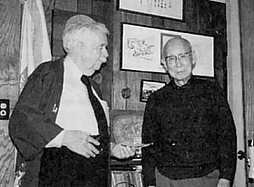Cooperation of Japanese National Institute of Health
by Isamu Nagai, M.D.
Associate Director, ABCC
Director, Nagasaki Branch Laboratory, JNIH, 1957-75

Dr. Nagai talks with Dr. Darling in a ‘happy-coat’.
To me there are no truer words than “Time flies like an arrow.” In fact, I was taken aback when I received Chairman Shigematsu’s letter. Could 40 years have really elapsed?
It was in October 1947 when I became involved in this research program. It was then that I first met Lt. Col. Tessmer, the first Director of the Atomic Bomb Casualty Commission (ABCC), and his party in the office of Dr. Hamano, Director, Bureau of Disease Prevention, Ministry of Health and Welfare, together with Dr. Rokuzo Kobayashi, the first Director of the Japanese National Institute of Health (JNIH), and others.
In Lt. Col. Tessmer’s party there were a number of men in military uniform with medals on their chest. At the request of Brigadier General Sams of General Headquarters of the Supreme Commander for Allied Powers, I agreed to cooperate with ABCC and in November of the same year made my first visit to Hiroshima for a preliminary survey. It was still soon after the termination of the war, and there were no hotels or other accomodations where I could stay in Hiroshima.
Subsequently, ABCC renovated the Gaisen-kan in Ujina-machi and made this its temporary research facilities. In the 1947 fiscal year JNIH obtained a supplementary budget for the initiation of its involvement in the research program. In the following year of 1948, a very small amount was incorporated in the principal budget of JNIH so that nominal participation could be commenced. We experienced a countless number of problems thereafter: personnel problems, labor problems, and problems related to the status of ABCC following the effectuation of the Peace Treaty, to name a few.
It was during the early period of these difficulties that Dr. Hiroshi Maki was assigned to Hiroshima and somehow managed to establish a pattern of cooperation. During this period I was stationed at JNIH headquarters in Tokyo and engaged in this collaborative endeavor, but in 1957 I was dispatched to Nagasaki to serve as the JNIH representative in Nagasaki.
ABCC had occupied the Gaisen-kan as its temporary facilities, but later moved to its present permanent facilities in Hijiyama. I still recall how moved the entire staff was emotionally at the opening ceremony and how there was an American member of the staff who, unable to suppress his joy, shed tears. That is how epochal and impressive the new facilities were. The research projects were based on large population samples and the results were subjected to statistical processing. As the methodology employed in these studies was unlike that utilized previously in Japan, there were some differences of opinion between the American and Japanese scientists, but the research achievements were truly remarkable.
Great advances have been made in radiation research in Japan. These may suggest superficially that all possible results have now been obtained, but the problems are not that easily solved. I consider it essential that in-depth inquiries and re-evaluations are made again and again from different angles. I hope the present staff engaged in the research program will dedicate itself even more to this vital endeavor.
In retrospect, I am grateful to have had the opportunity to become associated over the years with so many people and to receive their kind encouragement and support. Many have passed away, but memories of them remain fresh in my mind. My association with the staff has waned, since my retirement more than 10 years ago, but I extend my heartfelt wishes for the continued development of the Radiation Effects Research Foundation.
This article was originally published in RERF Newsletter 14 (40th anniversary special issue): 47-48, 1988

